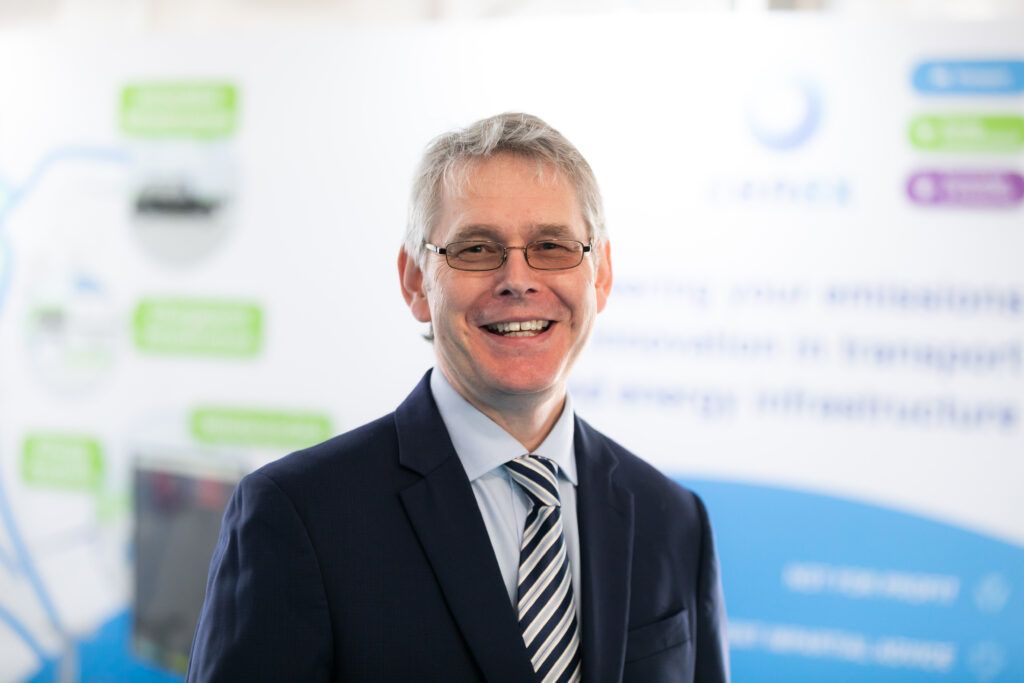Transport + Energy are the Content Partner for this year’s Cenex-LCV and CAM event which takes place on September 6 and 7 at UTAC Millbrook in Bedfordshire. In the lead up to the event, Editorial Director Alec Peachey is catching up with a number of speakers who will form part of the seminar programme. This week, he speaks to Robert Evans, CEO of Cenex – who tells us what visitors can expect to see and do.
Q. For anyone that doesn’t know, who are Cenex and what do you do?
A. ”Cenex is a Not-for-Profit Research and Consultancy Organisation. Our aim is to work collaboratively to help accelerate the transition to decarbonise road transport. We also deliver the co-located Cenex Low Carbon Vehicle and Cenex Connected Automated Mobility events which help the community showcase new innovations and share results from research and demonstration projects. We also aim to bring expert opinion formers together to discuss ‘what next’ for policy, technology and market development as the community looks to transition to road transport to Net Zero and see the successful market introduction of self-driving vehicles.”
Q. What sort of advances in low carbon vehicle technology can visitors expect to see at this year’s event?
A. ”We have over 200 exhibitors so there will be a very broad range of technologies on show both physically as exhibits but also visually through presentations within the CAM Tech Talk zone. There will be plenty for those interested in the components and systems for vehicle electrification and hydrogen technologies also.”
Q. In what way has the role of Cenex changed over the years and how has this been reflected in show advancements?
A. On the vehicle side, our very early events showcased a broad range of low carbon options but in the middle years, electrification became the consensus approach and we saw a big increase in technology showcasing for UK battery, power electronics, machines and drives developments.
”The electrification of passenger cars and vans has mainstreamed in the last 5 or so years, leaving the key unanswered question being how Heavy Goods Vehicle will transition to Net Zero.
”Electric vehicle charging has been an established feature of our event, with each new generation of lower cost fast charger and higher-powered EV charger showcased. In recent years the emphasis has moved toward new developments with wireless, along with smart and bi-directional charging to help manage local grid constraints and earn revenue form parked EVs. For Connected Automated Mobility we have seen the showcasing of UK developed automated Pods along with progress made to develop, test and verify the software for connectivity and automation that will enable the safe roll out of highly automated vehicles.”
Q. Tell us more about the different content streams this year. What will they be focused on and what can delegates expect to learn?
A. ”We broadly have two streams – one for low carbon stream and one for Connected Automated Mobility. For the low carbon stream, we have sessions addressing UK and international policy, technology development for batteries and motors, sessions on decarbonising Heavy Goods Vehicles and technology transfer from automotive to marine.
”For Connected Automated Mobility stream, we have policy sessions addressing safety assurance and regulation, sessions covering learning from demonstrators and Tech Talk sessions on the design, engineering and test for self-driving vehicles.”
Q. Do you think that most barriers have now been overcome to allow for the widespread adoption of electric vehicles? What barriers, if any, remain?
A. ”The technical barriers have been overcome. Its now a matter of scale-up for the motor industry supply chain and consumer acceptance of EVs.
”The energy system transition needed to support EV charging represents a potential barrier. The local distribution system will need upgrades to support more EV charging. For private motorists we will need more publicly accessible charging for those on journeys and those who can’t charge at home. Similarly, businesses will need more depot charging.”
Q. What do you think the EV situation will look like in 2030?
A. ”I am optimistic that a full range of EVs will be available for passenger car and light duty vehicles. For the heavy goods vehicle sector I would hope we have a technology, policy and market consensus as to the pathway for decarbonising the medium (to 26T) and heavy (to 44T) categories of Heavy Goods Vehicles.”
Q. What role do you see for hydrogen and other alternative fuels?
A. ”Hydrogen and E-Fuels are attracting attention primarily to decarbonise Heavy Goods Vehicles and Offroad equipment for construction. These heavy, hard-working vehicles are energy intensive, and this makes battery energy storage far more problematic that for lighter passenger cars. Hence the interest in alternatives. Hydrogen fuel cells are attractive as an electric vehicle option with zero emissions at the tailpipe and good tank-to-wheels energy efficiency. However, burning either hydrogen or E-Fuels in a truck engine offers an easier in-vehicle engineering route to ultra-low emissions.”
Q. How important are the targets around net zero when it comes to providing certainty to the market?
A. ”For most of the 15 years of the Cenex event we had aspiration targets which were helpful in supporting early introduction of new technologies. However, to transition a market, regulated targets are of critical importance. You see this with the firm dates now set for the phase out of Internal Combustion Engines and how these dates are providing the driving force behind the launch of so many new battery electric vehicles and the associated supply chain scale-up. ”
Q. What do you see as Cenex’s greatest opportunity leading up to 2030?
A. ”For Cenex our opportunity lies in two areas.
”The first is helping with the technology demonstration activity needed to extend the scope of electrification and hydrogen from light into heavy vehicles and across what are the “hard to decarbonise” sectors like offroad equipment.
”The second lies in developing decision support tools that help our customers to plan for their pathways to Net Zero. We don’t want our and others face-to-face support time to be a rate limiting factor in terms of supporting organisations to decarbonise their fleets and roll out EV charging infrastructure. Cenex already has a number of online tools that we are deploying in support of public sector organisations in the UK and see the opportunity to develop these for wider use case scenarios and also for international markets.
”For the Cenex Event, the opportunity lies in keeping the focus on innovation in terms of new technology can offer to accelerate the pace toward Net Zero but also drawing in more international visitors.
Q. What is the organisation’s greatest challenge leading up to 2030?
A. ”The scale of the transition to Net Zero will be a stretch for many organisations. There will be skills gaps that could be a barrier to progress. We see our activities as helping engage and educate.”
Q. How can we ensure that stakeholders collaborate and move further and faster towards achieving net zero?
”We can bring stakeholders together through activities like the Cenex Event. Information sharing and building partnerships between organisations is key to making progress to Net Zero. The old TEAM adage of Together Everyone Achieves More holds true for gaining traction for the transition to Net Zero.”
Q. Explain why it is important that both the public and private sector work together to ensure the transition to net zero happens at the required pace.
A. For the transition to Net Zero to be successfully achieved, public policy and industry investment will need to be aligned. At the implementation level, the public sector has a role to play as a customer for zero emission vehicles and ensuring national and regional strategies are aligned to support the associated transport and energy sector transition. Regional growth strategies can help support industry to invest locally within the UK. Public sector polices are shaped for public good and industry needs to ensure an evidence-based approach to help maintain support for what will be a concerted investment phase over an extended time-frame.”
Q. Finally, briefly summarise why visitors should attend this year’s Cenex-CAM event?
A. ”The three reasons to attend are the exhibition, the seminar programme and the networking. The exhibition always has new innovations being showcased.
”The seminar programme has over 150 expert speakers. Very few events could match the quality of the seminar programme and its free to attend. The event is known as a great place to network, whether catching up with existing contacts or making new connections. We are expecting c5,000 visitors over the 2 days of the event.”
Transport + Energy are the Content Partner for this year’s event and will be on Stand C4-204.
Click here to view the full programme.
Image courtesy of Cenex.








